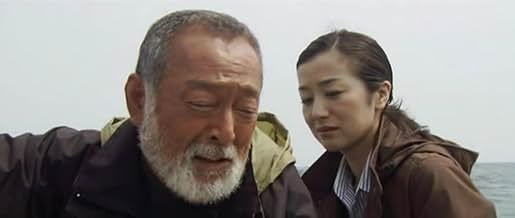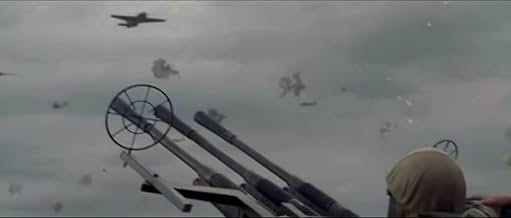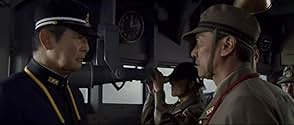Adicionar um enredo no seu idiomaThe movie follows 3 Japanese friends from embarking on Yamato, the world's largest battleship, until it's sunk 3 1/2 years later on April 7, 1945 on it's way to Okinawa to stop American adva... Ler tudoThe movie follows 3 Japanese friends from embarking on Yamato, the world's largest battleship, until it's sunk 3 1/2 years later on April 7, 1945 on it's way to Okinawa to stop American advance at the end of WWII.The movie follows 3 Japanese friends from embarking on Yamato, the world's largest battleship, until it's sunk 3 1/2 years later on April 7, 1945 on it's way to Okinawa to stop American advance at the end of WWII.
- Direção
- Roteiristas
- Artistas
- Prêmios
- 6 vitórias e 7 indicações no total
- Atsushi
- (as Sosuke Ikematsu)
Avaliações em destaque
So this movie once again skips over anything -- Japanese perspective or not -- about the war, and focuses on the only thing Japan has ever focused on since -- their own suffering.
The other thing is that the fight scenes make it look like they are at least making the US pay a heavy price. This is typical Japanese face- saving. If you are going to make a movie about these dead heroes to the state, you have to at least make it look like they died being somewhat competent. In fact, the count for the day was something like 10 US planes downed, and 14 pilots wounded. Considering that 4000 Japanese sailors died, this was an incredibly lopsided fight. So in other words, the battle must have looked very, very different than this movie.
I understand that a Japanese director probably cannot make a movie in which Japanese sailors are dying by the thousands -- and ARE NOT EVEN ABLE to inflict much damage in return. But that isn't US propaganda -- that is what happened. Surely at this point, it's time for someone to tell the young people of Japan something closer to the truth? Yes, Japan paid for its mistake, but it was not an innocent victim.
In 2001 I taught for six weeks in Japan, 2 weeks before, then later 4 weeks after 9/11. My students incredulously asked me in amazement "who would think of using an airplane as a suicide weapon and killing themselves and lots of other people?" They had not even HEARD of kamikazes! I did not have the heart to enlighten them, so I restrained my natural response "Your people invented this!"
Modern pacifist Japan is rooted in ignorance, and this movie contributes nothing to understanding. This is the telling of a war that happened in another dimension, not here. This is a tale from a Japan that still cannot own up to its own history.
The human story inside the story also is moving.
The major flaw of it, is that is too long. It gets unnecessary and frequently lost in details.
I am not racist nor nationalist. I also am not right wing. I oppose to any wars by any mean. But, I respect the men who fought for us and it is sad that we don't know much about the fact we are living on where these men protected.
I voted this as "5" for actors/actress are not that super... Theme song as the same... Understanding they did their best, but level of acting is miserable. The battle scenes are great.
Sometime it's too stereotype to illustrate the story (ie. Geisha & Japanese Gamble ... that's almost the all the Japanese movie does).
Though it praised the braveness of soldiers, it can't bear comparison with "Sink the Bismarck" (1960), in which the defeated Germany wined British's respect (It's ridiculous when a US veteran present his awedness to rival in the start and final of "Lorelei: The Witch of the Pacific Ocean" (2005)).
But this is not a historically narrative film. It also abandon the scanty criticism tradition of Japanese war movie before 90's. The tradition of vagueness of moral sense in Japanese movie is still there. No context was given to transmit the information about the cause to this tragedy, without which the sense of sacrifice to protect others is so pale. The script seemed to cater to the current civil circumstance. So this is a real "anniversary" movie within a predefined frame.
The cast were very good. Despite the unnaturalness of the plot corresponding to modern society, Tatsuya Nakadai is still my favorite actor. It's a pity that Japanese movie is losing its classic art orientation and international influence after the fade of masters directors.
The 3D effect is just so so, light is somewhat dim, and the color is always monotonously the hull's hue. Fortunately, the wave is no longer that appeared in old movie adopt the ship model. Music is better than "Lorelei: The Witch of the Pacific Ocean".
This film shows People. People in tragic times. People fighting for their loves and their lives. Whether it is Yamato, Saving Private Ryan, The Thin Red Line, Brotherhood, Stone's trilogy, Eastwood's duo of films, etc, it comes down to people trying to live. So much has been said about the film that is political but I ask you, what is the point of doing so for a film that strove so hard to in favour of a human story? After years of revisionist Hollywood war films, it is ironic that this moving film, Yamato, be raked over coals for inaccuracies or romanticism.
Besides this, however, and a technical note, the film's visual effects are excellent for a non-Hollywood film. I wouldn't be surprised if Yamato was one of the most expensive Japanese films ever made. While making an ocean going battleship replica was not an option, the sets, miniatures and CGI create a very gritty and realistic feeling of being aboard the fated ship.
Musically the film is also very striking and has some memorable themes throughout. The sound track is also superb with excellent separation in the 5.1 channels. The battle scenes are especially vivid in their aural presentation.
The amount of heart, work and effort that went into the film is clear from the exceptional cast, sound and competent visuals and their passionate and honest performances and work. This is definitely a film for the world to see. It is not a war film about "war"; it is a film about love. The message rings loud and clear until the final note of the closing credit's song.
Você sabia?
- CuriosidadesPart of the foredeck and port side of the Yamato were reconstructed to full scale for the exterior scenes. As the Japan Building Standards Act interfered with re-creating the ship's entire superstructure, images of a one-tenth scale model of the Yamato at its namesake museum in Kure were used in post-production.
- Erros de gravaçãoThe ship is seen firing salvos from its main batteries aimed at approaching US aircraft on several occasions, while lots of the crew are visible on deck, manning the light AA guns as well as performing other duties. While the big guns were in fact used fending off aircraft, at least during the last battle off Okinawa, the shock wave from the blast of the nine 460 mm barrels (the biggest ever on a warship) could kill or severely injure an unprotected sailor, it was therefore forbidden to remain on deck on such occasions.
- Citações
Mamoru Uchida: [Firing an AA gun defiantly as the ship sinks] I'm not done yet! My last throw!
Principais escolhas
- How long is Yamato?Fornecido pela Alexa
Detalhes
- Data de lançamento
- País de origem
- Central de atendimento oficial
- Idioma
- Também conhecido como
- Otoko-tachi no Yamato
- Locações de filme
- Empresas de produção
- Consulte mais créditos da empresa na IMDbPro
Bilheteria
- Faturamento bruto mundial
- US$ 39.287.114
- Tempo de duração
- 2 h 25 min(145 min)
- Cor
- Mixagem de som
- Proporção
- 2.35 : 1











